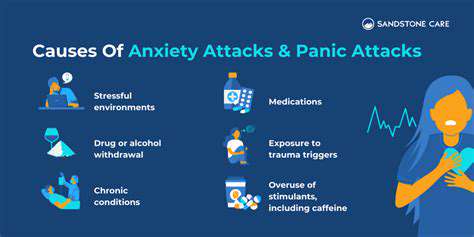Recognizing Panic Level Anxiety: Signs and Management Tips
Identifying the Telltale Signs of Panic Attacks
Recognizing the Physical Manifestations
Panic attacks are often accompanied by a cascade of physical symptoms that can be alarming and frightening. These physical sensations can range from a rapid heartbeat and shortness of breath to chest pain and dizziness. Individuals experiencing a panic attack may also report feeling a surge of heat or cold, trembling, sweating profusely, and experiencing nausea or stomach distress. Understanding these physical cues is crucial for recognizing a panic attack and taking appropriate steps to manage the situation. The abrupt onset of these physical symptoms can be particularly distressing, making it challenging to distinguish them from other medical conditions.
Recognizing these physical symptoms early can help a person seek immediate assistance or implement coping strategies. While these sensations can be frightening, they are typically temporary and not life-threatening. Learning to differentiate between normal anxiety responses and the more intense physical manifestations of a panic attack is a key step in developing effective coping mechanisms and preventing future episodes.
Understanding the Psychological Components
Beyond the physical symptoms, panic attacks also have significant psychological components. These include feelings of intense fear, dread, or impending doom. Individuals often describe experiencing a sense of losing control or going crazy during a panic attack. This overwhelming sense of fear can be debilitating, significantly impacting daily life. These psychological sensations can be just as distressing as the physical symptoms and contribute to the overall experience of a panic attack. It's important to acknowledge the emotional turmoil that accompanies these episodes and to develop coping strategies that address both the physical and mental aspects of the experience.
The psychological components of a panic attack can include a variety of thoughts and feelings, such as a fear of dying, losing control, or experiencing a heart attack. These catastrophic thoughts can exacerbate the panic, creating a vicious cycle that is difficult to break without intervention. Understanding the psychological aspects of panic attacks is essential for developing effective coping mechanisms and reducing the frequency and severity of these episodes.
Often, individuals experiencing panic attacks also report feelings of helplessness and isolation. This can lead to avoidance behaviors, where people try to prevent situations that might trigger a panic attack. Addressing these psychological factors is crucial for long-term management and recovery.
The fear of having another panic attack can itself become a source of anxiety, creating a cycle of fear and avoidance. Understanding this cycle is important in breaking it and learning to manage panic attacks effectively.
Recognizing the psychological elements of panic attacks is just as vital as acknowledging the physical symptoms. It helps individuals understand the full scope of the experience and gain valuable insights into their own responses to stress and anxiety.
Distinguishing Panic Attacks from Other Anxiety Symptoms

Understanding the Triggers
Panic attacks are often triggered by specific situations, thoughts, or even internal bodily sensations. Identifying these triggers is crucial for developing coping mechanisms. Understanding what precedes a panic attack can significantly reduce the frequency and intensity of future episodes. Recognizing patterns in your triggers can be a powerful tool in managing anxiety. For example, some people experience panic attacks in crowded spaces, while others are triggered by specific sounds or smells.
It's important to remember that triggers are highly individual and can change over time. What might have been a trigger in the past may no longer be a problem, or a new trigger might emerge. Staying attuned to your body and mind is essential for recognizing potential triggers.
Physical Symptoms vs. Panic Attack Symptoms
Many physical symptoms, like rapid heartbeat, shortness of breath, and sweating, can be mistaken for a panic attack. However, these symptoms can also be a result of other conditions, such as exercise, hyperthyroidism, or even certain medications. Careful observation and understanding of your body's responses are key.
Distinguishing between genuine panic attack symptoms and other physical symptoms requires a thorough understanding of your own body. Seeking medical advice from a healthcare professional can help clarify any concerns and rule out potential underlying medical issues. Don't self-diagnose; a doctor can provide accurate information.
Duration and Intensity of the Experience
A key differentiator between a panic attack and other anxiety-related experiences lies in the duration and intensity of the episode. Panic attacks typically peak within 10-20 minutes, and while the experience can feel overwhelming during that time, it is a temporary state. This is a crucial point because many other anxiety-related experiences can last longer and have a different intensity.
Panic attacks are characterized by a sudden surge of intense fear or discomfort that reaches its peak quickly. This intensity often leads to a feeling of impending doom or loss of control. Recognizing the rapid onset and short duration is a vital component of distinguishing a panic attack from other anxiety disorders.
Mental and Emotional Components
Beyond the physical sensations, panic attacks often involve intense mental and emotional components. These include feelings of terror, fear of losing control, impending doom, or going crazy. The mental distress associated with a panic attack can be just as debilitating as the physical symptoms.
These mental and emotional symptoms often accompany the physical sensations, adding to the overall experience of panic. A deep understanding of these mental and emotional components is essential to developing effective coping mechanisms. Understanding that the negative thoughts and feelings are temporary is an important step in managing the experience.
Seeking Professional Help
If you're experiencing frequent or intense panic attacks, seeking professional help is crucial. A mental health professional can provide a comprehensive evaluation, assess the underlying causes, and develop personalized strategies to manage your symptoms. This may involve therapy, medication, or a combination of both.
A mental health professional can provide invaluable support and guidance in navigating the challenges of panic attacks. Don't hesitate to reach out for help. Remember, you're not alone, and help is available.
